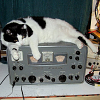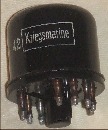Hey -
I want to update two old amps by taking out their two-prong power cords and putting in three-prong cords. How's it done? I've Googled it, and there are lots of tutorials for swapping wall sockets, but none for swapping cords.
Thanks!
Out with the two-prong, in with the three: HOW?
14 posts
• Page 1 of 1
Re: Out with the two-prong, in with the three: HOW?
Hot and neutral go the same place as the 2-prong and ground lead goes to the chassis.
Cheers!
Cheers!
-= Gregg =-
Fine wine comes in glass bottles, not plastic sacks. Therefore the finer electrons are also found in glass bottles.
Fine wine comes in glass bottles, not plastic sacks. Therefore the finer electrons are also found in glass bottles.
-

Geek - KT88
- Posts: 3585
- Joined: Sun Oct 21, 2007 3:01 am
- Location: Chilliwack, British Columbia
Re: Out with the two-prong, in with the three: HOW?
The black wire is HOT. There is full voltage between that wire and almost everything else.
The white wire is neutral. No voltage.
The green wire is the ground.
The black wire connects to the fuse or switch depending on your amp.
The white wire is neutral. No voltage.
The green wire is the ground.
The black wire connects to the fuse or switch depending on your amp.
Mike's N-1 Rule: When looking for N number of components to finish a job, you have a 95% chance of only finding N-1 of them.
-

mesherm - KT88
- Posts: 1232
- Joined: Fri Aug 27, 2004 10:33 pm
- Location: Alvin Texas
Re: Out with the two-prong, in with the three: HOW?
There could be an issue here. The black conductor's 120-V voltage will now be referenced to the chassis. It's possible for a ground loop to be created with other components such as a phono, etc.
Doug Criner
- dcriner
- KT88
- Posts: 309
- Joined: Mon Oct 23, 2006 4:19 pm
- Location: Illinois
Re: Out with the two-prong, in with the three: HOW?
There could be an issue here. The black conductor's 120-V voltage will now be referenced to the chassis. It's possible for a ground loop to be created with other components such as a phono, etc.
I have had that happen. On many of my amps I have installed a double throw switch on the rear of the chassis so I can either have the ground wire connected to the chassis or floating.
I have also heard of people connecting the ground to the chassis through two paralleled diodes with cathodes at opposite ends. The theory being the ground loop noise voltage is lower than the 0.7 volt drop of the diodes. so its kind of pseudo-floating while still having grounded protection. I have never tried it however so I don't know if it actually works.
Mike's N-1 Rule: When looking for N number of components to finish a job, you have a 95% chance of only finding N-1 of them.
-

mesherm - KT88
- Posts: 1232
- Joined: Fri Aug 27, 2004 10:33 pm
- Location: Alvin Texas
Re: Out with the two-prong, in with the three: HOW?
Something like this you were talking about?
Cheers!
Cheers!
- Attachments
-
- Ground_Loop_Isolator.png (6.69 KiB) Viewed 6689 times
-= Gregg =-
Fine wine comes in glass bottles, not plastic sacks. Therefore the finer electrons are also found in glass bottles.
Fine wine comes in glass bottles, not plastic sacks. Therefore the finer electrons are also found in glass bottles.
-

Geek - KT88
- Posts: 3585
- Joined: Sun Oct 21, 2007 3:01 am
- Location: Chilliwack, British Columbia
Re: Out with the two-prong, in with the three: HOW?
In my opinion, connecting the chassis to ground actually may increase the shock hazard. If, as originally designed, the chassis is isolated form ground, there is no voltage between the incoming black wire and the chassis. Ground the chassis, and if you come into contact with both the chassis and the hot, you will be shocked. If you really want to ground the chassis, then be sure to have a GFCI on the wall receptacle - even if there are just two conductors, it will still protect against a shock.
And, if the receptacle isn't wired correctly, the white wire will have 120-V above the chassis - even worse.
Tell me again why you want to ground a chassis that wasn't originally designed that way?
Should we connect our bedsprings to ground?
And, if the receptacle isn't wired correctly, the white wire will have 120-V above the chassis - even worse.
Tell me again why you want to ground a chassis that wasn't originally designed that way?
Should we connect our bedsprings to ground?
Doug Criner
- dcriner
- KT88
- Posts: 309
- Joined: Mon Oct 23, 2006 4:19 pm
- Location: Illinois
Re: Out with the two-prong, in with the three: HOW?
dcriner wrote:If you really want to ground the chassis, then be sure to have a GFCI on the wall receptacle...
YES!
I cannot agree with this more, from experience alone

-= Gregg =-
Fine wine comes in glass bottles, not plastic sacks. Therefore the finer electrons are also found in glass bottles.
Fine wine comes in glass bottles, not plastic sacks. Therefore the finer electrons are also found in glass bottles.
-

Geek - KT88
- Posts: 3585
- Joined: Sun Oct 21, 2007 3:01 am
- Location: Chilliwack, British Columbia
Re: Out with the two-prong, in with the three: HOW?
Yeah, and then what happens if in the future somebody moves the amp to a non-GFCI receptacle?
Doug Criner
- dcriner
- KT88
- Posts: 309
- Joined: Mon Oct 23, 2006 4:19 pm
- Location: Illinois
Re: Out with the two-prong, in with the three: HOW?
dcriner wrote:Yeah, and then what happens if in the future somebody moves the amp to a non-GFCI receptacle?
And all dams should be able to handle 100X their normal amount of water, and all buildings should be able to withstand a F5 and 10.0 earthquake. You can't protect everyone all the time. Sometimes the weak must fall, the strong will survive, but the weak must fall. Fall, fall, fall.
At first I wanted to be a ET. Now I are one.
-

DeathRex - KT88
- Posts: 1014
- Joined: Wed Nov 18, 2009 8:13 pm
- Location: Cortez, CO
Re: Out with the two-prong, in with the three: HOW?
Tell me again why you want to ground a chassis that wasn't originally designed that way?
I'm still hoping for an answer to my question.
Doug Criner
- dcriner
- KT88
- Posts: 309
- Joined: Mon Oct 23, 2006 4:19 pm
- Location: Illinois
Re: Out with the two-prong, in with the three: HOW?
I didn't at first, but now I am. There was a post on DIYAudio about using old power transformers, and the greater possibility of the transformer shorting from primary to the secondary or to the core. There was also something about the split bobbin used now, don't know if everyone uses them, but of course the split bobbin has a slim chance of shorting primary to secondary.
At first I wanted to be a ET. Now I are one.
-

DeathRex - KT88
- Posts: 1014
- Joined: Wed Nov 18, 2009 8:13 pm
- Location: Cortez, CO
Re: Out with the two-prong, in with the three: HOW?
dcriner wrote:... If you really want to ground the chassis, then be sure to have a GFCI on the wall receptacle - even if there are just two conductors, it will still protect against a shock.
And, if the receptacle isn't wired correctly, the white wire will have 120-V above the chassis - even worse.
Tell me again why you want to ground a chassis that wasn't originally designed that way?
Good question.
As you know, not every outlet has a GFCI. And how often do electric guitarists play in kitchens or bathrooms? I do usually use a power strip. Does that give the same protection that a GFCI gives?
It's not particularly the chassis that I want to ground. I want to ground the amp, using a three-prong plug.
I've used amps with two-prong plugs, and they're too squirrelly. Supposedly you can tell by the hum whether you need to throw the ground switch (or turn the plug over), but in real life, there usually isn't a difference in hum level between one side and the other. Amps hum. For all kinds of reasons.
With a three-prong plug, you don't need a ground switch. Just plug and play - safely. Which is why the first thing most guitarists who buy old amps do is get a three-prong plug installed. I've never met anyone who's regretted it.
Hope that explains it. Thanks!
- Charlie Bernstein
- Posts: 13
- Joined: Wed Oct 07, 2015 9:41 am
Re: Out with the two-prong, in with the three: HOW?
mesherm wrote:The black wire is HOT. There is full voltage between that wire and almost everything else.
The white wire is neutral. No voltage.
The green wire is the ground.
The black wire connects to the fuse or switch depending on your amp.
Thanks! On the two-prong chord, the colors are black and brown.
Both go to metal prongs sticking out of the back of a round socket with four square holes in front.
The brown wire goes to a prong that also has the left-hand wire of a ceramic cap ("20% 2220 2KV") and a black wire leading away from it. (I can't see where the black wire goes.)
The power cord's black wire goes to the prong to the right of the other one, to which the right-hand side of that ceramic cap is attached.
So:
Is the black still hot and the brown neutral?
Where would the green of the three-prong wire go?
- Charlie Bernstein
- Posts: 13
- Joined: Wed Oct 07, 2015 9:41 am
14 posts
• Page 1 of 1
Who is online
Users browsing this forum: No registered users and 10 guests
